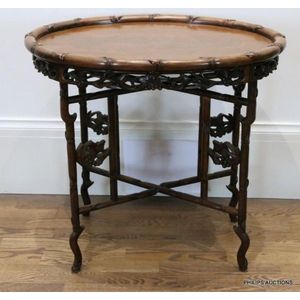Chinese Bamboo Patterned Folding Table, Republic Period, c1920s
A Chinese bamboo patterned occasional folding table, Republic period, c1920s the oval top with a faux bamboo carved border above a pierced fruiting vine frieze, raised on a folding base with shaped legs further carved with bamboo stems and grapevine motifs. Height 71 cm, length 76 cm, width 56 cm
You must be a subscriber, and be logged in to view price and dealer details.
Subscribe Now to view actual auction price for this item
When you subscribe, you have the option of setting the currency in which to display prices to $Au, $US, $NZ or Stg.
This item has been sold, and the description, image and price are for reference purposes only.
- Grapevine Motif - The grapevine motif is a decorative design that features grapevines, leaves, and grapes and is commonly used in various forms of art and decoration, including jewellery, textiles, pottery, and architecture.
In jewellery, the grapevine motif is often used to create decorative elements such as pins, brooches, necklaces, and bracelets. The design can be executed in a variety of materials, including precious metals such as gold and silver, and can be embellished with gems or enamel.
The grapevine motif is a popular symbol in many cultures, representing abundance, prosperity, and fertility. In ancient times, grapevines were associated with Dionysus, the Greek god of wine and celebration, and were used to decorate wine vessels, temples, and other sacred objects.
In addition to its cultural significance, the grapevine motif is also appreciated for its aesthetic appeal. The intertwining branches and clusters of grapes create a graceful, flowing design that is both beautiful and versatile. Whether used in jewellery, textiles, or other forms of decorative arts, the grapevine motif continues to be a popular and enduring symbol of abundance and prosperity. - Republic Period - The Chinese Republic period, also known as the Republic of China period, lasted from 1912 to 1949. It began with the overthrow of the Qing Dynasty in 1911 and the establishment of the Republic of China under Sun Yat-sen. During this period, the country underwent significant political, social, and economic changes, including the adoption of a new constitution, the expansion of civil liberties, and the modernization of the economy. However, the Republic of China period was also marked by political instability, with numerous warlords and factions vying for power and influence, and the country was eventually engulfed in a civil war between the Nationalists and the Communists. The Republic of China period came to an end in 1949, when the Communists emerged victorious and established the People's Republic of China, while the Nationalists retreated to Taiwan where they established a separate government.
- Frieze - An architectural term denoting the flat, shaped or convex horizontal surface of furniture, between the architrave and the cornice, usually found on a cabinet or bookcase, or on desks and tables where it may include drawers, the area between the top and the legs. In ceramics, the term refers to the banding, of usually a repeating pattern, on the rims of plates and vases.
- Faux - A French word meaning "false", but when used in decorative arts, the intention is not to deceive, but to simulate the decorative effects of the more expensive material it is imitating. The term " faux bois" meaning "false wood" refers to a furniture item that has been decorated with a marked grain (woodgrain finish) to imitate a more expensive timber.
This item has been included into following indexes:
- Chinese furniture, chairs
- Chinese furniture, tables
- furniture, period or style - oriental 1,735
